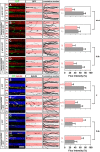Ephexin1 Is Required for Eph-Mediated Limb Trajectory of Spinal Motor Axons
- PMID: 29363583
- PMCID: PMC6705882
- DOI: 10.1523/JNEUROSCI.2257-17.2018
Ephexin1 Is Required for Eph-Mediated Limb Trajectory of Spinal Motor Axons
Abstract
The precise assembly of a functional nervous system relies on the guided migration of axonal growth cones, which is made possible by signals transmitted to the cytoskeleton by cell surface-expressed guidance receptors. We investigated the function of ephexin1, a Rho guanine nucleotide exchange factor, as an essential growth-cone guidance intermediary in the context of spinal lateral motor column (LMC) motor axon trajectory selection in the limb mesenchyme. Using in situ mRNA detection, we first show that ephexin1 is expressed in LMC neurons of chick and mouse embryos at the time of spinal motor axon extension into the limb. Ephexin1 loss of function and gain of function using in ovo electroporation in chick LMC neurons, of either sex, perturbed LMC axon trajectory selection, demonstrating an essential role of ephexin1 in motor axon guidance. In addition, ephexin1 loss in mice of either sex led to LMC axon trajectory selection errors. We also show that ephexin1 knockdown attenuates the growth preference of LMC neurites against ephrins in vitro and Eph receptor-mediated retargeting of LMC axons in vivo, suggesting that ephexin1 is required in Eph-mediated LMC motor axon guidance. Finally, both ephexin1 knockdown and ectopic expression of nonphosphorylatable ephexin1 mutant attenuated the retargeting of LMC axons caused by Src overexpression, implicating ephexin1 as an Src target in Eph signal relay in this context. In summary, our findings demonstrate that ephexin1 is essential for motor axon guidance and suggest an important role in relaying ephrin:Eph signals that mediate motor axon trajectory selection.SIGNIFICANCE STATEMENT The proper development of functioning neural circuits requires precise nerve connections among neurons or between neurons and their muscle targets. The Eph tyrosine kinase receptors expressed in neurons are important in many contexts during neural-circuit formation, such as axon outgrowth, axon guidance, and synaptic formation, and have been suggested to be involved in neurodegenerative disorders, including amyotrophic lateral sclerosis and Alzheimer's disease. To dissect the mechanism of Eph signal relay, we studied ephexin1 gain of function and loss of function and found ephexin1 essential for the development of limb nerves toward their muscle targets, concluding that it functions as an intermediary to relay Eph signaling in this context. Our work could thus shed new light on the molecular mechanisms controlling neuromuscular connectivity during embryonic development.
Keywords: axon guidance; motor neuron; spinal cord.
Copyright © 2018 the authors 0270-6474/18/382043-14$15.00/0.
Figures







Similar articles
-
Paxillin Is Required for Proper Spinal Motor Axon Growth into the Limb.J Neurosci. 2021 Apr 28;41(17):3808-3821. doi: 10.1523/JNEUROSCI.2863-20.2021. Epub 2021 Mar 16. J Neurosci. 2021. PMID: 33727334 Free PMC article.
-
Nck2 is essential for limb trajectory selection by spinal motor axons.Dev Dyn. 2018 Sep;247(9):1043-1056. doi: 10.1002/dvdy.24656. Epub 2018 Sep 6. Dev Dyn. 2018. PMID: 30016580
-
SRC family kinases are required for limb trajectory selection by spinal motor axons.J Neurosci. 2009 Apr 29;29(17):5690-700. doi: 10.1523/JNEUROSCI.0265-09.2009. J Neurosci. 2009. PMID: 19403835 Free PMC article.
-
Eph and ephrin signaling: lessons learned from spinal motor neurons.Semin Cell Dev Biol. 2012 Feb;23(1):83-91. doi: 10.1016/j.semcdb.2011.10.016. Epub 2011 Oct 21. Semin Cell Dev Biol. 2012. PMID: 22040916 Review.
-
Axon pathfinding for locomotion.Semin Cell Dev Biol. 2019 Jan;85:26-35. doi: 10.1016/j.semcdb.2017.11.014. Epub 2017 Nov 14. Semin Cell Dev Biol. 2019. PMID: 29141181 Review.
Cited by
-
Paxillin Is Required for Proper Spinal Motor Axon Growth into the Limb.J Neurosci. 2021 Apr 28;41(17):3808-3821. doi: 10.1523/JNEUROSCI.2863-20.2021. Epub 2021 Mar 16. J Neurosci. 2021. PMID: 33727334 Free PMC article.
-
Neuronal guanine nucleotide exchange factor promotes the axonal growth and cancer cell proliferation via Ephrin-A3/EphA2 axis in lung adenocarcinoma.J Transl Med. 2025 Feb 28;23(1):246. doi: 10.1186/s12967-025-06233-8. J Transl Med. 2025. PMID: 40022166 Free PMC article.
-
Interactions between EGFR and EphA2 promote tumorigenesis through the action of Ephexin1.Cell Death Dis. 2022 Jun 6;13(6):528. doi: 10.1038/s41419-022-04984-6. Cell Death Dis. 2022. PMID: 35668076 Free PMC article.
-
Emerging Roles of Ephexins in Physiology and Disease.Cells. 2019 Jan 24;8(2):87. doi: 10.3390/cells8020087. Cells. 2019. PMID: 30682817 Free PMC article. Review.
-
Akt-mediated Ephexin1-Ras interaction promotes oncogenic Ras signaling and colorectal and lung cancer cell proliferation.Cell Death Dis. 2021 Oct 28;12(11):1013. doi: 10.1038/s41419-021-04332-0. Cell Death Dis. 2021. PMID: 34711817 Free PMC article.
References
-
- Bladt F, Aippersbach E, Gelkop S, Strasser GA, Nash P, Tafuri A, Gertler FB, Pawson T (2003) The murine nck SH2/SH3 adaptors are important for the development of mesoderm-derived embryonic structures and for regulating the cellular actin network. Mol Cell Biol 23:4586–4597. 10.1128/MCB.23.13.4586-4597.2003 - DOI - PMC - PubMed
-
- Defourny J, Poirrier AL, Lallemend F, Mateo Sánchez S, Neef J, Vanderhaeghen P, Soriano E, Peuckert C, Kullander K, Fritzsch B, Nguyen L, Moonen G, Moser T, Malgrange B (2013) Ephrin-A5/EphA4 signalling controls specific afferent targeting to cochlear hair cells. Nat Commun 4:1438. 10.1038/ncomms2445 - DOI - PubMed
Publication types
MeSH terms
Substances
LinkOut - more resources
Full Text Sources
Other Literature Sources
Molecular Biology Databases
Miscellaneous
